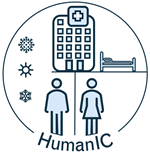The human-centric indoor climate (HCC) is defined as the microenvironment which surrounds and is close to a human body. The HCC concept focuses on human beings and surrounding environment, which should be understood as a specific microenvironment more than just the ‘physical neighbourhood’ of a human body. The HCC in hospitals plays a vital role in enabling safe and effective provision of healthcare. Operating rooms (ORs), isolation rooms, treatment rooms and laboratory facilities all enable increasingly sophisticated treatment to be safely delivered to patients, while wards, consulting rooms and waiting rooms provide essential facilities for the interaction of patients and their comfort and wellbeing during recovery. However, there are significant challenges of HCC within hospital environments. Over 4 million patients are estimated to acquire a healthcare-associated infection (HAI) in the EU each year, and on any given day, about 80 000 patients have at least one HAI, i.e. one in every 18 patients in European hospitals.
The global crisis of antimicrobial resistance means that HAI is posing an increasing cost and risk of mortality. The hospital environment is responsible for 20% of all HAI, and there is clear
evidence that the design of buildings and human activities contribute to transmission of infectious diseases. An improved indoor environment of a hospital building can reduce costs associated
with airborne illnesses by 9%‐20%. Ventilation and indoor air is a particular concern, and numerous studies show that airflow controls the dispersion and exposure to airborne pathogens. That was also recognised by the WHO in the case of the Covid-19 pandemic, when many hospitals work beyond capacity, with patients recover in rooms that were never designed for the purpose. This is further compounded by a changing climate that is increasing healthcare demands (future pandemics, heat-related illnesses and infections; surgical site infection (SSI), and mortality), challenging hospitals to maintain comfortable thermal conditions of HCC, and at the same time driving hospitals to reduce the energy consumption.
Promoting good health is integral to the Europe 2030 strategy, and includes the objective “to contribute to innovative, efficient and sustainable health systems and to facilitate access to high
quality, safe healthcare for EU citizens”. To deliver this goal, there is an urgent need for innovation in healthcare indoor environments to tackle the combined challenges of infection
control, thermal comfort and wellbeing and energy efficiency in both new and existing hospitals. To achieve this, there is a substantial research challenge to advance the fundamental understanding
of how people are exposed to airborne pathogens in HCC and develop new tools and techniques to enable effective design and operation of healthcare environments. However there are gaps in
understanding the local influence of airflows on particles in HCC, quantifying the transient behaviour of airflows and contaminants due to healthcare activities, methods for optimising and
adapting ventilation systems to control for risks in different environments, tools to enable realtime interaction with environments during design and operational phases.
The HumanIC network aims to build a new approach to hospital environmental design through the concept of a human-centric indoor climate. Rather than the traditional approach of focusing
solely on the building and its ventilation/heating systems, the network will develop new approaches to integrate the multi-dynamic interaction between contamination sources and airflow distribution
systems with the clinical, patient and energy requirements of the hospital environment.
We will consider the human interactions with the indoor environments and how this affects transient dispersion of contaminants, particularly in protected risky microenvironments such as
surgery; it is a central prerequisite for the safe operation of these facilities to eliminate or minimise airborne pathogen threats while at the same time ensuring good thermal comfort. We will generate
new knowledge on the physical processes of transmission and contaminant-airflow interactions, and apply this knowledge to optimize the design of technical solutions, and develop novel methods to
visualise and control HCC in hospital environments.
Through an ambitious research programme and a tailored training programme, HumanIC will provide a new generation of scientists and engineers who understand the implications of these
complex interfaces in future hospital design. In building the HumanIC consortium we will actively promote healthcare environment engineering as an inclusive and diverse career option at all
stages in the programme, including aiming to recruit at least 50% women. We will ensure that the HumanIC recruitment process and training environment is attractive, welcoming, inclusive and
supportive, allowing men and women appointed as Doctoral Candidates (DCs) to engage with the network to fully maximize their scientific and personal potential.


